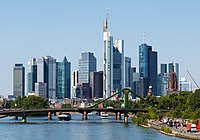
Neubrandenburg is a city in the southeast of Mecklenburg-Vorpommern, Germany. It is located on the shore of a lake called Tollensesee and forms the urban centre of the Mecklenburg Lakeland.

Demmin is a town in the Mecklenburgische Seenplatte district, Mecklenburg-Western Pomerania, in north-eastern Germany. It was the capital of the former district of Demmin.
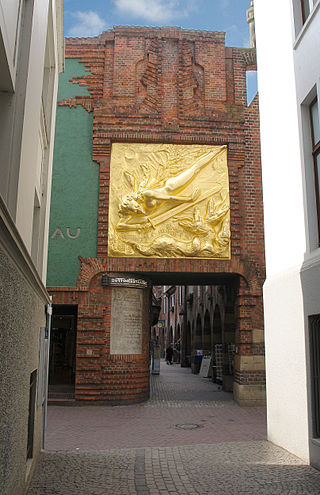
Böttcherstraße is a street in the historic centre of Bremen, Germany. Only about 100 m (330 ft) long, it is famous for its unusual architecture and ranks among the city's main cultural landmarks and visitor attractions. Most of its buildings were erected between 1922 and 1931, primarily as a result of the initiative of Ludwig Roselius, a Bremen-based coffee-trader, who charged Bernhard Hoetger with the artistic supervision over the project. The street and its buildings are a rare example of an architectural ensemble belonging to a variant of the expressionist style. Several of the houses can be classed as Brick Expressionism. Since 1973, the ensemble has been protected by the Monument Protection Act.

The Cologne Public Library is among the biggest and most important public libraries in Germany. The central library is part of the 'Kulturquartier' near the Neumarkt. It is located at the Josef-Haubrich-Hof, with the new Rautenstrauch-Joest-Museum in its immediate neighbourhood. Since 2008, Dr. Hannelore Vogt has been the director of the library.

Marienkirche, a hall church in the North German red brick Gothic style, completed in 1298, was the main church of the city of Neubrandenburg. It has been transformed into a concert hall, designed by Pekka Salminen, which opened in 2001. It then was rededicated as the Konzertkirche. It is widely known for its renowned Philharmony.

The Altes Stadthaus is a former administration building in Bonn, Germany, built for the French occupation forces after World War I. It was designed by the Munich architect German Bestelmeyer in 1922. Construction was completed in 1924–25. The building most recently served as a public library and administration building. As of 2012, the Altes Stadthaus is being renovated and extended as a "House of Learning", which will accommodate the community college and the library.

The Märkisches Museum is a museum in Mitte, Berlin. Founded in 1874 as the museum of the city of Berlin and its political region, the March of Brandenburg, it occupies a building on the northern edge of Köllnischer Park, facing the Spree, which was designed by Ludwig Hoffmann and completed in 1908. It is now the main facility of the Stiftung Stadtmuseum Berlin, Landesmuseum für Kultur und Geschichte Berlins, the City of Berlin museum foundation, which also operates four other sites.

Haus der Stadtsparkasse is a Rococo landmark on the "Marktplatz" in Bremen, Germany. It was completed in the 1950s combining the historic front gable from another site with the more recent architecture of the remainder of the building.

The old Rathscafé, now named Deutsches Haus, is a listed building on the market place (Marktplatz) in Bremen. It is part of the monument ensemble No. 1–21.

Domsheide is a major square in the city of Bremen, Germany. It is located east of the Marktplatz and south of Bremen Cathedral. Streets leading to it include Ostertorstraße, Dechanatstraße, Balgebrückstraße and Violenstraße. It contains a number of important buildings, including the main post office, the courthouse, the cathedral precinct with the bell, and the annex to the stock market building. It is one of three main hubs of the public transport network, with most tram routes and two important bus lines crossing the square. The design of the Domsheide is relatively uneven, characterized by materials such as sandstone, dark red brick, red and yellow clinkers, render, concrete and marble.

The Glockenspiel House is a building in Bremen in the north of Germany. With its 30 bells of Meissen porcelain, the carillon (Glockenspiel) chimes three times a day while wooden panels depicting pioneering seafarers and aviators appear on a rotating mechanism inside the tower.
Culture House or House of Culture may refer to:

Stargard Castle is the northernmost extant hill castle in Germany. The 13th century castle, standing on a 90 m hill, and the eponymous small town in the valley below lie several kilometers southeast of Neubrandenburg, in the northeastern German state of Mecklenburg-Vorpommern. The complex consists of an outer and an inner bailey with eleven buildings preserved. The imposing castle keep serves as the city's landmark.

The Warburg Haus, Hamburg is a German interdisciplinary forum for art history and cultural sciences and primarily for political iconography. It is dedicated to the life and work of Aby Warburg and run by the University of Hamburg as a semi-independent seminar. "It issues a series of art historical publications directly modeled on the original institution's studies and lectures, and is a sponsor of the reprinted 'Study Edition' released through the Akademie Verlag in Berlin."

Schloss Wolfenbüttel is a castle in Wolfenbüttel, Lower Saxony, Germany. An extensive four-wing complex, it originated as a moated castle (Wasserburg). It is the second-largest surviving schloss in Lower Saxony and served as the main residence of the rulers of the Principality of Brunswick-Wolfenbüttel from 1432 to 1753. It now houses a gymnasium secondary school, the Federal Academy of Arts Education, and a museum with its historic rooms on display. Its immediate vicinity is home to several historically significant buildings including the Herzog August Bibliothek, the Lessinghaus, the Zeughaus, and the Kleines Schloss.
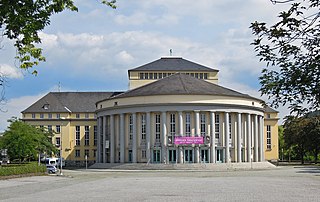
Theater Saarbrücken, officially Saarländisches Staatstheater since 1971, is the state theatre of Saarland in its capital Saarbrücken, Germany. It has several divisions and offers annually around 30 new productions in around 700 events for more than 200,000 people. Its venues are Großes Haus, Alte Feuerwache, Congresshalle and sparte4. While theatre in Saarbrücken has a long history, the present main venue was completed in 1938, with plans commissioned by the Nazi regime.
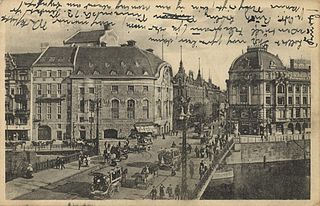
The old Komische Oper was a privately run Opera house in Berlin-Mitte, Friedrichstraße 104, at the Weidendammer Bridge. It is not to be confused with today's Komische Oper Berlin, Behrenstraße 55-57. The naming Komische Oper referred to the Parisian Opéra-Comique.
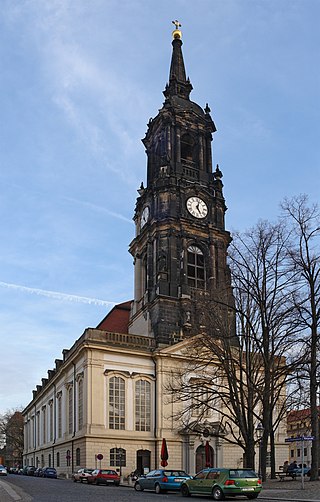
The Dreikönigskirche is a Lutheran church located in the Innere Neustadt of Dresden, Germany. It is the centre of a parish, and a community venue called Haus der Kirche. The church is a listed cultural monument of Dresden.

